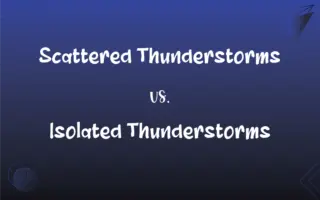Sandy Soil vs. Loamy Soil: What's the Difference?
Edited by Janet White || By Harlon Moss || Published on January 29, 2024
Sandy soil is coarse-textured, drains quickly, and has low nutrient content, while loamy soil is a balanced mix of sand, silt, clay, and organic matter, with good drainage and high fertility.

Key Differences
Sandy soil is characterized by large, coarse particles, leading to quick water drainage and poor water retention. In contrast, loamy soil, with its balanced texture, has better moisture retention while still allowing adequate drainage.
Due to its coarse nature, sandy soil heats up quickly and tends to be low in nutrients as they are easily washed away. Loamy soil, rich in organic matter, retains nutrients effectively, providing a fertile environment for plant growth.
Sandy soil's loose structure makes it easy to work with but less suitable for supporting plant structures. Loamy soil offers a stable structure for root development, making it ideal for a wide range of plants.
In terms of water management, sandy soil requires frequent watering as it dries out quickly. Loamy soil, with its optimal balance, requires less frequent watering, maintaining consistent moisture levels.
For gardening purposes, sandy soil may need amendments like organic matter to improve its fertility and water retention. Loamy soil is often considered ideal for gardening without the need for significant amendments.
ADVERTISEMENT
Comparison Chart
Texture
Coarse, large particles
Balanced mix of sand, silt, clay, organic matter
Water Drainage
Drains quickly, poor retention
Good drainage, retains moisture
Nutrient Content
Low, nutrients wash away easily
High, retains nutrients
Suitability for Plants
Limited, needs modifications for most plants
Highly suitable for a wide range of plants
Maintenance
Requires frequent watering, nutrient amendments
Requires less frequent watering, minimal amendments
ADVERTISEMENT
Sandy Soil and Loamy Soil Definitions
Sandy Soil
Soil primarily composed of sand particles.
The cacti thrived in the sandy soil of the desert.
Loamy Soil
Soil with good water retention and drainage.
The flowers flourished in the well-drained loamy soil.
Sandy Soil
Soil with large, coarse grains and a gritty texture.
The sandy soil in the garden drained water too quickly.
Loamy Soil
Soil that is easy to work and suitable for most plants.
The loamy soil made planting the shrubs effortless.
Sandy Soil
A type of soil with minimal nutrient retention.
He added compost to the sandy soil to enrich it.
Loamy Soil
A soil type that is neither too sandy nor too clayey.
The loamy soil maintained the perfect balance for root growth.
Sandy Soil
Soil that warms up quickly in the sun.
The sandy soil was perfect for early spring planting.
Loamy Soil
Soil composed of a balanced mix of sand, silt, and clay.
The loamy soil in her garden was ideal for growing vegetables.
Sandy Soil
Soil with poor water retention properties.
Watering the plants in the sandy soil was a daily task.
Loamy Soil
A fertile soil type rich in organic matter.
His secret to lush plants was the nutrient-rich loamy soil.
FAQs
How does sandy soil affect plant growth?
Poor nutrient and water retention can hinder growth.
What is loamy soil?
A balanced mix of sand, silt, clay, and organic matter.
Does loamy soil require frequent watering?
Generally no, due to its good moisture retention.
What defines sandy soil?
Predominantly sand particles, coarse texture.
Can sandy soil retain water well?
No, it tends to drain water quickly.
What makes loamy soil fertile?
Its high organic matter and nutrient retention capacity.
Is sandy soil naturally fertile?
It's typically low in nutrients.
Can loamy soil support a wide range of plants?
Yes, it's suitable for most plant types.
How does loamy soil benefit root growth?
It provides stability and optimal moisture for roots.
Why is loamy soil considered ideal for gardening?
It offers optimal drainage, nutrient content, and texture.
How do you improve sandy soil for planting?
By adding organic matter like compost.
How do you identify sandy soil?
By its gritty texture and loose structure.
Does sandy soil warm up quickly?
Yes, it heats up faster than denser soils.
Are there any advantages to using sandy soil?
It's easy to till and good for certain plants like cacti.
Can sandy soil be used for lawn grass?
It may require amendments for better grass growth.
Is loamy soil good for vegetable gardens?
Yes, it's often the best choice for vegetables.
Is sandy soil acidic or alkaline?
It varies, but often it is slightly acidic.
What does loamy soil feel like?
It's smooth, moist, and crumbly.
Does loamy soil require a lot of fertilizers?
Usually not, due to its natural fertility.
Is loamy soil easy to cultivate?
Yes, it's usually easy to work with.
About Author
Written by
Harlon MossHarlon is a seasoned quality moderator and accomplished content writer for Difference Wiki. An alumnus of the prestigious University of California, he earned his degree in Computer Science. Leveraging his academic background, Harlon brings a meticulous and informed perspective to his work, ensuring content accuracy and excellence.
Edited by
Janet WhiteJanet White has been an esteemed writer and blogger for Difference Wiki. Holding a Master's degree in Science and Medical Journalism from the prestigious Boston University, she has consistently demonstrated her expertise and passion for her field. When she's not immersed in her work, Janet relishes her time exercising, delving into a good book, and cherishing moments with friends and family.

































































